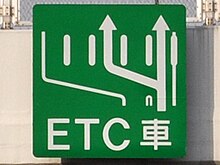Tokyo city highway
| Shuto Kōsokudōro KK Metropolitan Expressway Co., Ltd. |
|
|---|---|
| legal form | Kabushiki kaisha (joint stock company) |
| founding | October 1, 2005 |
| Seat | Kasumigaseki , Chiyoda , Tokyo Prefecture |
| management | Keiichirō Hashimoto, President & Executive Director |
| Number of employees | 1,120 (March 31, 2010) |
| sales | 497 billion yen (FY 2009/10) |
| Branch | Infrastructure |
| Website | www.shutoko.jp |
The Shuto Kōsokudōro KK ( Japanese. 首都 高速 道路 株式会社 , lit. "Capital Highways AG", English Metropolitan Expressway Co., Ltd. ) is the operator of the Tokyo city highway , which with around 300 km network most of the highways in and makes up around the districts of Tokyo . It mainly opens up the east of Tokyo Prefecture , but also extends into the neighboring prefectures of Kanagawa , Saitama and Chiba . It should not be confused with the Tokyo Highway ( Tōkyō Kōsokudōro ).
The company emerged in 2005 from the public company of the same name ( kōdan ) founded in 1959 . The main shareholders with almost half of the shares are the Ministry of Land, Infrastructure and Transport, followed by the prefectures of Tokyo and Kanagawa, who together hold almost a third of the shares. As Tokushu-gaisha ( 特殊 会 社 , "special society ") such as B. the NTT , the Tokyo Metro or JT , the Shuto Kōsokudōro KK was created by its own law, namely the kōsokudōro-kabushiki-gaisha-hō ( 高速 道路 株式会社 法 , "Highway Stock Corporation Act "): the central government or the local authorities therefore always own at least one third of the shares. The issuance of bonds or capital increases also require the approval of the ministry.
The company's task is to operate and maintain the motorways. The route is owned by the national Nihon kōsokudōro hoyū, saimu hensai kikō ( 日本 高速 道路 保有 ・ 債務 返 済 機構 , "Organization for Ownership and Debt Repayment of the Highways of Japan", English Japan Expressway Holding and Debt Repayment Agency) , which was set up at the same time as the privatization in 2005 , JEHDRA for short), a self-governing body of the ministry. This also assumes ownership rights and liabilities for newly built routes.
Route network
The main routes of the Tokyo city highway are connected to the inner ring C1 , which runs through the districts of Chūō , Chiyoda and Minato . From there go six clockwise numbered routes, the routes with the higher numbers 7, 9, 10 and 11 only partially fit into this scheme. The middle ring ( chūō-kanjō-sen ) C2 has been built since 1982, which leads from Tokyo Bay through the outer districts of Tokyo and, except for a section in the southwest (planned completion 2013), together with line B ( wangan-sen , B as in English Bayshore Route ) forms a closed ring. Further routes lead to the prefectures of Kanagawa (K1 to K6) and Saitama (S2, S5) and connect the megacities of Kawasaki , Yokohama and Saitama to the network. Chiba in the east is connected by routes of the east Japanese highway operator Higashi-Nihon Kōsokudōro (NEXCO Higashi-Nihon), which connect to lines 7 and B. NEXCO Higashi-Nihon also operates the Gaikan jidōshadō ("Outer Ring Highway", English Gaikan Expressway ), which is supposed to form a third ring, but so far only leads from the Tokyo district of Nerima through the south of Saitama Prefecture.
In Japanese, the route names consist of a place or route name and sometimes the route number, e.g. B. ichi-gō Haneda-sen ( 1 号 羽 田 線 ), thus "No. 1 Haneda Line ", wangan-sen ( 湾 岸線 )," Bay Coast Line ", or toshin-kanjō-sen ( 都 心 環状 線 )," inner city ring line ". On street signs, all are shown together with the Latin letters and / or the associated numbers.
-
Ring roads :
-
C1 inner ring
- Line no. 8 (Kyōbashi JCT - Higashi-Ginza) forms the connection to the Tōkyō Kōsokudōro ; but it is only 100 meters long and is signposted as part of the inner ring.
- C2 middle ring
-
C1 inner ring
-
Arterial roads :
- No. 1 Ueno Line (Edobashi JCT - Iriya)
- No. 1 Haneda Line (Hamazaki-bashi JCT - Tama Highway Bridge)
- No. 2 Meguro Line (Ichinohashi JCT - Togoshi)
- No. 3 Shibuya Line (Tanimachi JCT - Yōga)
- No. 4 Shinjuku Line (Miyakezaka JCT - Takaido)
- No. 5 Ikebukuro Line (Takebashi JCT - Bijogi JCT)
- No. 6 Mukōjima Lineage (Edobashi JCT - Horikiri JCT)
- No. 6 Misato Line (Kosuge JCT - Misato JCT)
- No. 7 Komatsugawa Line (Ryōgoku JCT - Yagouchi)
- No. 9 Fukagawa Line (Hakozaki JCT - Tatsumi JCT)
- No. 10 Harumi Line (Toyosu - Shinonome JCT, under construction)
- No. 11 Daiba Line (Shibaura JCT - Ariake JCT)
- Other routes in Tokyo:
- Kanagawa:
- K1 Yokohane Line (Tama Highway Bridge - Ishikawachō JCT)
- K2 Mitsusawa Line (Kinkō JCT - Mitsuzawa)
- K3 Kariba Line (Honmoku JCT - Kariba)
- K4 Isogo line (abandoned in the planning phase)
- K5 Daikoku Line (Namamugi JCT - Daikoku JCT)
- K6 Kawasaki Line (Tonomachi - Kawasaki-Ukishima JCT)
- B Wangan Line (Namiki - Tama Tunnel)
- Saitama:
Prices
Unlike most Japanese long-distance routes, the prices for the Tokyo urban highway are not distance-dependent. Cars, minibuses and vans pay a flat rate of 700 yen for one-time use on the Tokyo routes, 600 on the Kanagawa lines and 500 on the Saitama lines; certain routes such as the Haneda Airport Expressway cost 300 yen. Large coaches and trucks pay 1,400 yen in Tokyo and lower prices on the other routes.
Since 1997, payment has been increasingly converted to the electronic accounting system ETC ( Electronic Toll Collection ). ETC users pay reduced prices at night and on Sundays and public holidays.


